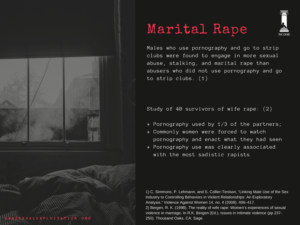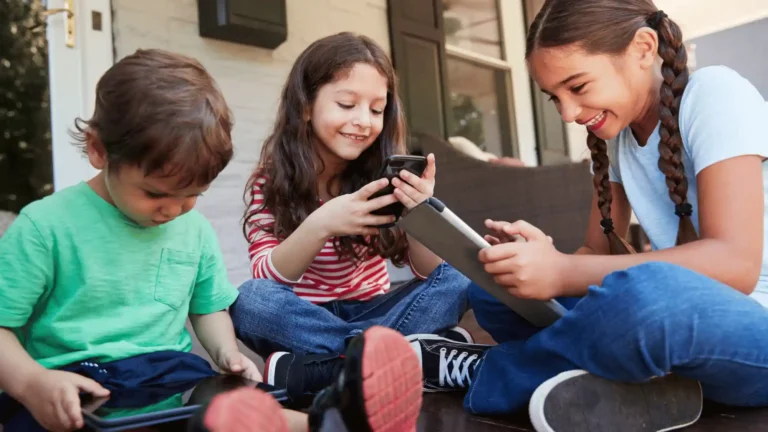This article was written with assistance from Emily Hale.
October is Domestic Violence Awareness Month, an important national campaign to consider prevention and recovery efforts, along with the nature of, domestic violence which impacts millions of both men and women in America.1
Here at the National Center on Sexual Exploitation, we work to address the intersectionality between all forms of sexual exploitation and abuse all year long. We recognize that issues like domestic violence do not occur in a vacuum, but are instead shaped and reinforced by issues like prior childhood sexual abuse, sexual assault, and pornography.
While all of these topics are worth considering, we want to highlight three ways domestic violence intersects with pornography.
1. Pornography Sets Expectations of Violence and Abuse.
Pornography fosters aggression by normalizing and depicting verbal and physical violence as enjoyable.
Aggressive acts against women in pornography occur in roughly 87% of the scenes, and 95% of the time when these acts are committed, women respond with expressions of pleasure or neutrality.2 Pornography acts as a form of sexual education, teaching the lesson that female sexual partners ought to enjoy physical acts such as hitting, gagging, slapping, or nonconsensual sex. Unsurprisingly, the research is clear that even mainstream pornography use by frequent viewers is associated with greater intent to commit rape3—a real danger for an domestic abuse victim/survivor.
Every abuser is responsible for his or her own harmful actions, but if our society is working to prevent abuse, it is vital to acknowledge the societal influences that normalize and encourage abuse.

2. Sometimes Abusers Use Couple-Made Pornography or Nude Images to Manipulate Victims
Behaviors like threatening, isolating, gas lighting and more, are hallmarks of domestically abusive relationships. Sometimes abusers use couple-made pornography or nude images to coerce or punish victims in abusive relationships by threatening to, or actually, sharing them.
The term “revenge pornography” is often not connected to domestic violence or abusive relationships, but the reality is that these phenomena often overlap.
“Domestic violence sounds like a serious thing, and sharing pictures doesn’t always sound serious to people.” Mary Anne Franks, J.D., a professor at the University of Miami School of Law said in an interview with Self.com. “But these things can’t be separated—nonconsensual [sharing of] pornography is becoming one of the most common ways to try to control and intimidate a partner.”4
In fact, a legal director at a domestic violence agency in California stated that threats about revenge pornography is now a trend in abusive relationships. “It’s become something that we expect to see in a lot of our cases. We expect it to be part of the narrative: ‘He beats me, he isolated me from my family and my friends, he won’t let me leave the house, he tells me I’m stupid, and he tells me if I ever leave him he’ll send my pictures to my family.’”
The good news is that 40 states and Washington DC5 now have laws against nonconsensual sharing of pornography, but the bad news is we still have a long way to go to educate the public on the harmful impact of revenge porn and its link to abusive relationships.
3. Pornography Use by Domestic Abusers Can Increase the Odds of Sexual Assault
In a study of 271 battered women, it was found that 30% of the abusers reportedly used pornography.6
The study concluded that “the majority of women (58%) whose abusers used pornography acknowledged that the pornography had affected their abuse… We certainly have enough evidence to warrant identifying pornography use as a risk factor, much like alcohol consumption, associated with sexual violence.”
In another study of 40 survivors of marital rape, pornography was used by one third of the abusive partners—often women were forced to watch pornography and to enact what they had seen.7
Further, pornography use is linked to marital rape, which is a form of domestic abuse. Research from the journal Violence Against Women found that men who use pornography and go to strip clubs were found to engage in higher rates of sexual abuse, stalking and marital rape than those who did not use pornography or strip clubs.8

The Director of the Gold Coast Centre Against Sexual Violence, Di Macleod wrote:
“In the past few years we have had a huge increase in intimate partner rape of women from 14 to 80+. The biggest common denominator is consumption of porn by the offender. With offenders not able to differentiate between fantasy and reality, believing women are ‘up for it’ 24/7, ascribing to the myth that ‘no means yes and yes means anal’, oblivious to injuries caused and never ever considering consent. We have seen a huge increase in deprivation of liberty, physical injuries, torture, drugging, filming and sharing footage without consent.”9
It’s time to recognize the links between pornography and domestic violence, in order to provide better services to victims and better prevention programs to make abuse and exploitation intolerable throughout our culture.
If our society is going to form a comprehensive response to #domesticviolence, it is vital to begin acknowledging the role of pornography. Click To TweetIf you or a loved one are victims in a domestically abusive relationship, the National Domestic Violence Hotline is 1-800-799-7233, with more information at https://www.thehotline.org/.
If you or a loved one are trying to get nonconsensually shared pornography off of the internet visit this page on the Cyber Civil Right website and/or the DMCA Takedown.
For more information about the harms of pornography and NCOSE’s resources in overcoming a pornography addiction, click https://endsexualexploitation.org/resources-struggling/.
1 The National Intimate Partner and Sexual Violence Survey (NISVS): 2010-2012 State Report. Atlanta, GA, National Center for Injury Prevention and Control, Centers for Disease Control and Prevention
2 Ana J. Bridges, Robert Wosnitzer, Erica Scharrer, Chyng Sun, and Rachael Liberman, “Aggression and Sexual Behavior in Best-Selling Pornography Videos: A Content Analysis Update,” Violence Against Women 16, no. 10 (2010): 1065-1085
3 Foubert, J., Brosi, M., & Bannon, S. (2011). Pornography viewing among fraternity men: Effects on bystander intervention, rape myth acceptance & behavioral intent to commit sexual assault. Sexual Addiction & Compulsivity, 18: 212-231.
4 Goldberg, Haley. „Revenge Porn: When Domestic Violence Goes Viral” 2017. https://www.self.com/story/revenge-porn-domestic-violence
5 https://www.cybercivilrights.org/revenge-porn-laws/
6 Janet Hinson Shope, “When Words Are Not Enough: The Search for the Effect of Pornography on Abused Women,” Violence Against Women 10, no. 1 (2004): 56-72
7 Bergen, R. K. (1998). The reality of wife rape: women’s experiences of sexual violence in marriage. In R.K. Bergen (Ed.) Issues in intimate violence (pp 237-250). Thousand Oaks, CA: Sage.
8 C. Simmons, P. Lehmann, and S. Collier-Tension, “Linking Male Use of the Sex Industry to Controlling Behaviors in Violent Relationships: An Exploratory Analysis,” Violence Against Women 14, no. 4 (2008): 406-417
9 Di Macleod, Director of the Gold coast Centre Against Sexual Violence, personal correspondence to Melinda Tankard Reist, 7 April 2015. https://www.collectiveshout.org/why_domestic_violence_will_rule_for_as_long_as_pornography_exists


